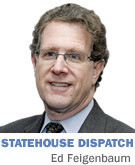Subscriber Benefit
As a subscriber you can listen to articles at work, in the car, or while you work out. Subscribe Now
 Tired of all-RFRA, all the time? Well, get over it, because between now and Election Day 2016, that’s all that matters in Indiana. (You might read about the new Indiana University basketball five-star recruit without an RFRA reference. In case you missed it, that second-coming signing was lost in the RFRA static.)
Tired of all-RFRA, all the time? Well, get over it, because between now and Election Day 2016, that’s all that matters in Indiana. (You might read about the new Indiana University basketball five-star recruit without an RFRA reference. In case you missed it, that second-coming signing was lost in the RFRA static.)
The Religious Freedom Restoration Act has become such an important part of our Hoosier quilt that, like the Equal Rights Amendment 40 years ago, it simply goes by the acronym.
But realize this: RFRA has become so deeply ingrained in so short a time that everyone is talking about it, and not just the media and political chattering class (which ordinarily would be moving on to the next “gotcha” story and trying to dissect the impact of the biennial budget). RFRA is on that same two-year cycle election-wise, but what’s more important is how it will affect the final weeks of the legislative session.
For practical purposes, Gov. Mike Pence has largely become irrelevant through session’s end. While he might be changing a travel schedule that had called for several out-of-state political visits during the final days of April, that will not have much in-state meaning.
Senate President Pro Tem David Long, R-Fort Wayne, and House Speaker Brian Bosma, R-Indianapolis, swept up the RFRA political and policy detritus in the governor’s trail at the end of March, effectively installing them at the top of a political and policy food chain that—through April, at least—will not resemble the “co-equal branch of government” model instilled in fourth-grade Hoosiers.
The speaker of the House is said to be the most powerful person in the state while the Legislature is in session, and that distinction will certainly ring true through the end of the month, even as some wonder about the role Bosma and Long played in allowing the original RFRA to be enacted, and whether they should be just as much to blame as the governor for failing to see around the proverbial corner.
After all, Bosma once bottled up right-to-work over concerns for the process, and more recently, Long did the same with the same-sex marriage definition amendment.
These will be the two men prescribing the bottom lines on all legislation through month’s end, and they will do so knowing that the governor has lost his ability to go over the heads of legislators and appeal to the public on any issue—or simply to use the power and prestige of his office to make it uncomfortable for lawmakers to cross him.
That will not be the situation this month, as veto overrides require only a constitutional majority—the same number of votes as to pass a bill. Where solons might have been willing to adjust things to match the governor’s preferences in close calls, such as on gambling expansion, that might no longer be a legislative consideration.
The other two lawmakers who will take the lead heading into conference committee deliberations are Senate Committee on Appropriations Chairman Luke Kenley, R-Noblesville, and House Committee on Ways and Means Chairman Tim Brown, R-Crawfordsville.
The duo will be most responsible for shaping the budget, and they will be focused on the revenue-collection forecast at mid-month to refine its contours. Most watching monthly numbers expect the forecast to be mediocre, and Kenley has been concerned about conflicting data (such as low unemployment rates but low personal income), the lack of sustained over-the-year growth, and the failure to consistently meet even revised revenue targets.
Kenley is likely to prevail upon Brown and the House to trim spending based on the forecast. With no appetite to scale back education dollars, the likely alternative will be to excise some of the governor’s proposed expenditures, and to phase in outlays.
The RFRA fallout ensures that the final weeks will be played out on the third floor of the Statehouse, with less of the usual interplay between branches.•
__________
Feigenbaum publishes Indiana Legislative Insight. He can be reached at edf@ingrouponline.com.
Please enable JavaScript to view this content.
